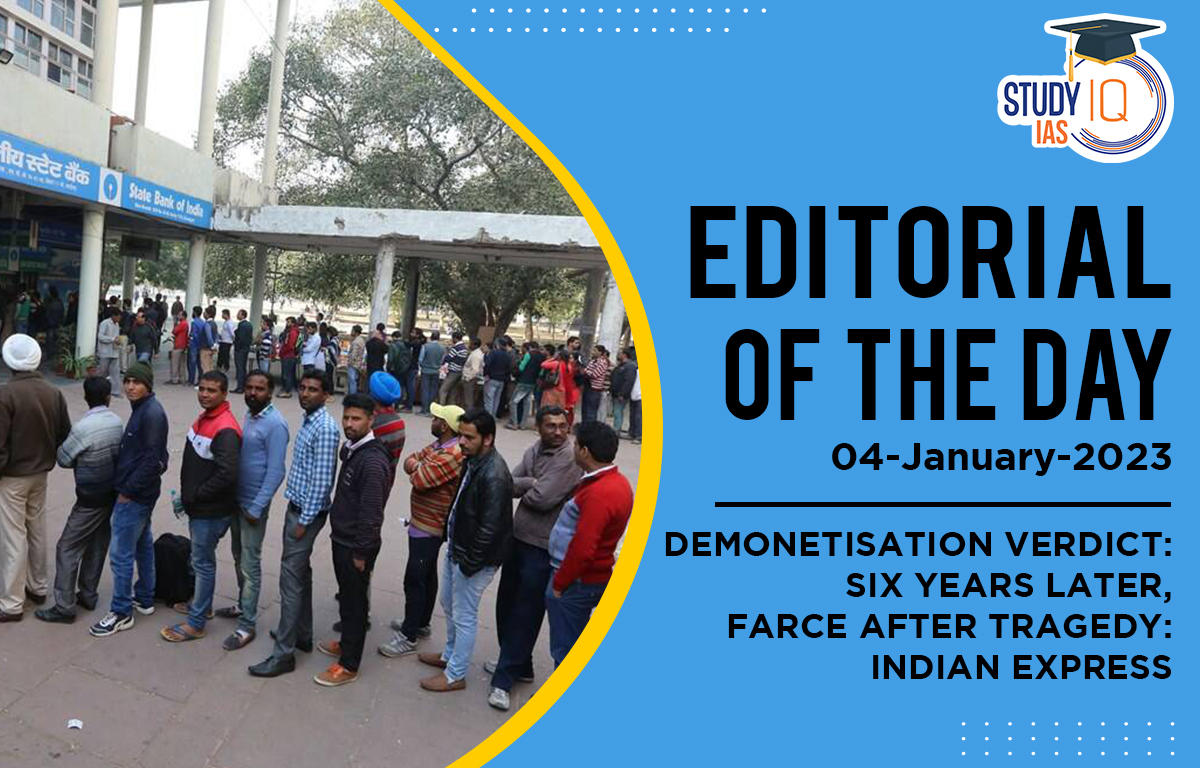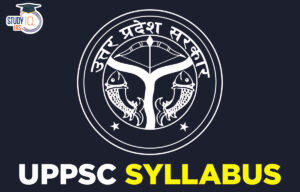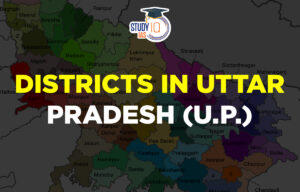Table of Contents
Exam View: Demonetization in India, SC upholds Demonetization decision, Majority view on Demonetization, Minority view on Demonetization, Critical analysis of Demonetization
In News: The Supreme Court has upheld the government’s 2016 decision to demonetise currency notes of Rs 500 and Rs 1,000 by a 4:1 majority.
- The Court identified six issues in the challenge to the government’s demonetisation decision. Both the majority judgment and the dissent gave their views on each of these issues.
- Demonetization is the process through which a nation’s economic unit of exchange loses its legally enforceable validity. Currencies that are terminated are no more legally considered exchanges and have no financial value. It is a process by which countries opt to reintroduce defunct currencies as legal money.
Demonetization in India
- 1946: The RBI demonetized Rs. 1,000 and Rs. 10,000 currency notes which were then under circulation.
- 1954: The Government introduced new currency notes of Rs. 1,000, Rs. 5,000, and Rs. 10,000.
- 1978: The Janata Party Government under Morarji Desai demonetized Rs. 1,000, Rs. 5,000, and Rs. 10,000 to curb illegal transactions and anti-social activities.
- 2016: The Government took a move to outlaw all 500-rupee and 1,000-rupee notes – 86 per cent of the cash in circulation – to target undeclared “black money” and fight corruption.
SC Upholds Demonetization Decision

Majority View on Demonetization
- The time provided for the exchange of demonetised notes was reasonable: The court referred to the judgment of a Constitution Bench in Jayantilal Ratanchand Shah Vs RBI (1996) which upheld the validity of 1978’s Demonetisation Act.
- Legitimate interests of the state: The majority verdict states that curbing fake currency, black money and terror funding are legitimate interests of the state and have a rational nexus with demonetisation. The court has to determine if the decision was necessary and that there were no alternative measures that could have achieved a similar purpose with a lesser degree of harm for citizens.
- Doctrine of “proportionality: There was consultation between the Centre and the Reserve Bank of India (RBI) for six months indicating a reasonable nexus between the measures undertaken and the object sought to be achieved and, therefore, the demonetisation passed the test of doctrine of “proportionality”.
Doctrine of Proportionality
- Proportionality is a ground for judicial review. In India, the doctrine of proportionality was adopted by the Supreme Court of India in the case of Om Kumar v. Union of India.
- Proportionality means that the administrative action should not be more drastic than it ought to be for obtaining the desired result.
- In K.S. Puttaswamy vs Union of India (2017) case, the court held that any restriction placed on the right must conform to a doctrine of proportionality.
This requires few tests,
- State action must have a legislative mandate
- The action must show that the objective of its law is founded on a legitimate governmental aim
- It must be proportionate, i.e., such state action — both in its nature and extent, must be necessary for a democratic society. Further, such action must have no alternative and less intrusive measures available to achieve the same objective
- The principle of proportionality calls for striking down of laws that are excessively harsh or disproportionate.
Minority View on Demonetization
- Instead of using executive notification, it must be done through legislation: The demonetisation of all series of notes at the instance of the central government is a far more serious issue than the demonetisation of a particular series by the bank.
- Section 26(2) only contemplates the demonetisation of banknotes at the instance of the Central Board of the RBI: However, since in this case the proposal was not initiated by the RBI, the demonetisation exercise could have been undertaken by the central government only through an ordinance or a parliamentary law.
- The dissenting judge also said that the word ‘any’ in sub-section (2) of Section 26 cannot be read to mean ‘all series of bank notes’ as this would vest with the Central Board of the Bank unguided and unlimited powers.
- Inability of RBI to independently apply thought: The dissenting judge held that the central bank did not apply its mind independently while recommending the cancellation of Rs 500 and Rs 1000 notes as proposed by the Centre.
Critical Analysis of Demonetization
- Black money is not just cash: The sudden demonetization was premised on the idea that “black means cash”. And it is in high-denomination currency notes that black money would be held.
- Wealth is dispersed: The wealth is held in a variety of forms like, undervalued inventory or balances held in tax havens abroad. A return is expected from this wealth. So, cash, on which there is no return, would be a tiny amount – 1% of the black wealth.
- Schemes were exploited: Deposits in Jan Dhan accounts suddenly swelled as the poor were used as cash mules. Some bankers were caught helping their rich clients do this. There was a 30% charge for this. As a result, new black incomes got generated.
- Benami transactions whiten black money: The truth is that illegal cash transactions, though black money, constitute a very small proportion of the black economy.
- Much cash was accounted for: Much of the prospected cash in circulation including a major chunk of ‘black money’ was collected back by the RBI.
- Fuss over fastest growth: Official data showed that the year of demonetization, 2016-’17, had the best growth rate for the decade. The reason is that unorganised sector data is not available, so the GDP data uses the organised sector as a proxy to capture it.
- Embraced as a failure: Demonetisation is perceived as an ill-advised step that did not achieve any of its goals. The ruling party understood this and did not showcase it as an achievement in the subsequent elections.
- Suspicion over timings: Some suggested that demonetization was ordered for political reasons – that it was crucial to win the impending UP elections. It was thought that if the Opposition lost its black-money hoards, it would not be able to campaign effectively.
- Bluff over objectives: Within days, the government changed the goalpost. It argued that the move would make the economy “cashless”. After a few months, the goal became a “less cash economy”.
- According to data from the Reserve Bank of India, the currency in circulation (CIC) in value terms soared from INR 17.74 lakh crore on November 4, 2016, to INR 32.42 lakh crore on December 23, 2022. This indicates that demonetization had no discernible impact on CIC in the country. Demonetization brought about a policy-induced crisis for the country, adversely impacting the marginalized sections of society – women, farmers, and workers – while doing little to curb the black economy. However, it can be termed as a good, intended policy with hasty execution.


 UPPSC Syllabus 2024, Check PCS Prelims a...
UPPSC Syllabus 2024, Check PCS Prelims a...
 World Liver Day 2024, Theme, History, Ce...
World Liver Day 2024, Theme, History, Ce...
 List of Districts of Uttar Pradesh, Map,...
List of Districts of Uttar Pradesh, Map,...

















